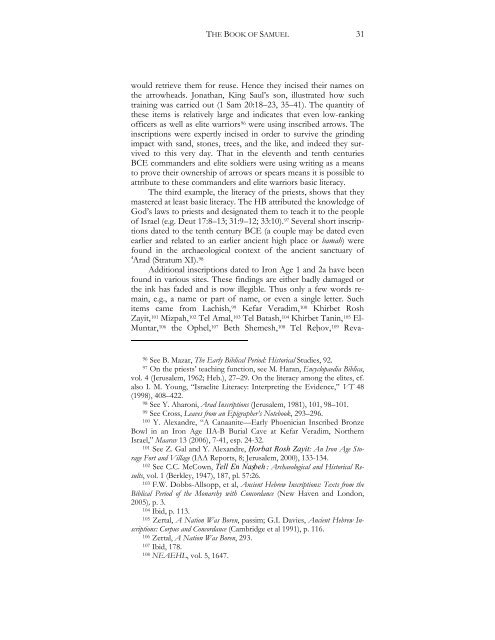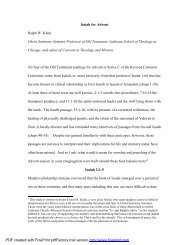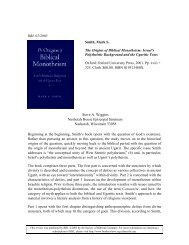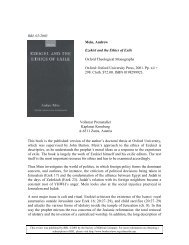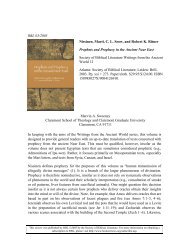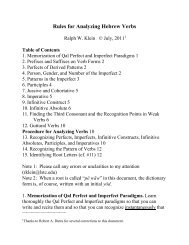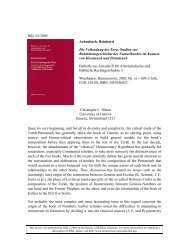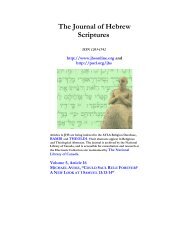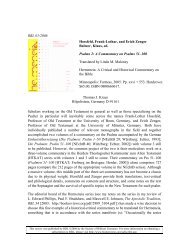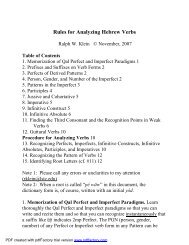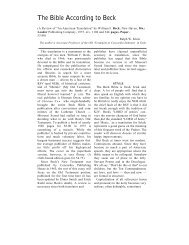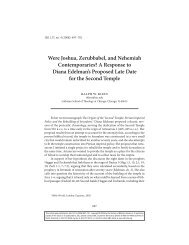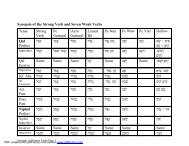The Book of Samuel: Its Composition, Structure and Significance as ...
The Book of Samuel: Its Composition, Structure and Significance as ...
The Book of Samuel: Its Composition, Structure and Significance as ...
Create successful ePaper yourself
Turn your PDF publications into a flip-book with our unique Google optimized e-Paper software.
THE BOOK OF SAMUEL<br />
would retrieve them for reuse. Hence they incised their names on<br />
the arrowheads. Jonathan, King Saul’s son, illustrated how such<br />
training w<strong>as</strong> carried out (1 Sam 20:18–23, 35–41). <strong>The</strong> quantity <strong>of</strong><br />
these items is relatively large <strong>and</strong> indicates that even low-ranking<br />
<strong>of</strong>ficers <strong>as</strong> well <strong>as</strong> elite warriors 96 were using inscribed arrows. <strong>The</strong><br />
inscriptions were expertly incised in order to survive the grinding<br />
impact with s<strong>and</strong>, stones, trees, <strong>and</strong> the like, <strong>and</strong> indeed they survived<br />
to this very day. That in the eleventh <strong>and</strong> tenth centuries<br />
BCE comm<strong>and</strong>ers <strong>and</strong> elite soldiers were using writing <strong>as</strong> a means<br />
to prove their ownership <strong>of</strong> arrows or spears means it is possible to<br />
attribute to these comm<strong>and</strong>ers <strong>and</strong> elite warriors b<strong>as</strong>ic literacy.<br />
<strong>The</strong> third example, the literacy <strong>of</strong> the priests, shows that they<br />
m<strong>as</strong>tered at le<strong>as</strong>t b<strong>as</strong>ic literacy. <strong>The</strong> HB attributed the knowledge <strong>of</strong><br />
God’s laws to priests <strong>and</strong> designated them to teach it to the people<br />
<strong>of</strong> Israel (e.g. Deut 17:8–13; 31:9–12; 33:10). 97 Several short inscriptions<br />
dated to the tenth century BCE (a couple may be dated even<br />
earlier <strong>and</strong> related to an earlier ancient high place or bamah) were<br />
found in the archaeological context <strong>of</strong> the ancient sanctuary <strong>of</strong><br />
‘Arad (Stratum XI). 98<br />
Additional inscriptions dated to Iron Age 1 <strong>and</strong> 2a have been<br />
found in various sites. <strong>The</strong>se findings are either badly damaged or<br />
the ink h<strong>as</strong> faded <strong>and</strong> is now illegible. Thus only a few words remain,<br />
e.g., a name or part <strong>of</strong> name, or even a single letter. Such<br />
items came from Lachish, 99 Kefar Veradim, 100 Khirbet Rosh<br />
Zayit, 101 Mizpah, 102 Tel Amal, 103 Tel Bat<strong>as</strong>h, 104 Khirbet Tanin, 105 El-<br />
Muntar, 106 the Ophel, 107 Beth Shemesh, 108 Tel Reḥov, 109 Reva-<br />
96 See B. Mazar, <strong>The</strong> Early Biblical Period: Historical Studies, 92.<br />
97 On the priests’ teaching function, see M. Haran, Encyclopaedia Biblica,<br />
vol. 4 (Jerusalem, 1962; Heb.), 27–29. On the literacy among the elites, cf.<br />
also I. M. Young, “Israelite Literacy: Interpreting the Evidence,” VT 48<br />
(1998), 408–422.<br />
98 See Y. Aharoni, Arad Inscriptions (Jerusalem, 1981), 101, 98–101.<br />
99 See Cross, Leaves from an Epigrapher’s Notebook, 293–296.<br />
100 Y. Alex<strong>and</strong>re, “A Canaanite—Early Phoenician Inscribed Bronze<br />
Bowl in an Iron Age IIA-B Burial Cave at Kefar Veradim, Northern<br />
Israel,” Maarav 13 (2006), 7-41, esp. 24-32.<br />
101 See Z. Gal <strong>and</strong> Y. Alex<strong>and</strong>re, Horbat Rosh Zayit: An Iron Age Storage<br />
Fort <strong>and</strong> Village (IAA Reports, 8; Jerusalem, 2000), 133-134.<br />
102 See C.C. McCown, Tell En N<strong>as</strong>beh : Archaeological <strong>and</strong> Historical Results,<br />
vol. 1 (Berkley, 1947), 187, pl. 57:26.<br />
103 F.W. Dobbs-Allsopp, et al, Ancient Hebrew Inscriptions: Texts from the<br />
Biblical Period <strong>of</strong> the Monarchy with Concordance (New Haven <strong>and</strong> London,<br />
2005), p. 3.<br />
104 Ibid, p. 113.<br />
105 Zertal, A Nation W<strong>as</strong> Boren, p<strong>as</strong>sim; G.I. Davies, Ancient Hebrew Inscriptions:<br />
Corpus <strong>and</strong> Concordance (Cambridge et al 1991), p. 116.<br />
106 Zertal, A Nation W<strong>as</strong> Boren, 293.<br />
107 Ibid, 178.<br />
108 NEAEHL, vol. 5, 1647.<br />
31


